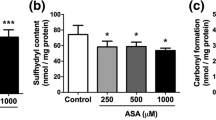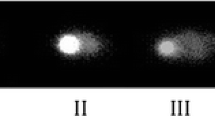Abstract
In the present study we investigated the effects of L-pyroglutamic acid (PGA), which predominantly accumulates in the inherited metabolic diseases glutathione synthetase deficiency (GSD) and γ-glutamylcysteine synthetase deficiency (GCSD), on some in vitro parameters of energy metabolism and lipid biosynthesis. We evaluated the rates of CO2 production and lipid synthesis from [U-14C]acetate, as well as ATP levels and the activities of creatine kinase and of the respiratory chain complexes I-IV in cerebral cortex of young rats in the presence of PGA at final concentrations ranging from 0.5 to 3 mM. PGA significantly reduced brain CO2 production by 50% at the concentrations of 0.5 to 3 mM, lipid biosynthesis by 20% at concentrations of 0.5 to 3 mM and ATP levels by 52% at the concentration of 3 mM. Regarding the enzyme activities, PGA significantly decreased NADH:cytochrome c oxireductase (complex I plus CoQ plus complex III) by 40% at concentrations of 0.5–3.0 mM and cytochrome c oxidase activity by 22–30% at the concentration of 3.0 mM, without affecting the activities of succinate dehydrogenase, succinate:DCPIP oxireductase (complex II), succinate:cytochrome c oxireductase (complex II plus CoQ plus complex III) or creatine kinase. The results strongly indicate that PGA impairs brain energy production. If these effects also occur in humans, it is possible that they may contribute to the neuropathology of patients affected by these diseases.
Similar content being viewed by others
REFERENCES
Meister, A. 1974. The γ-glutamyl cycle. Diseases associated with specific deficiencies. Anal. Intern. Med. 81:247–253.
Van der Werf, P. and Meister, A. 1975. The metabolic formation and utilization of 5-oxo-L-proline (L-pyroglutamate, L-pyrrolidone carboxylate). Adv. Enzym. 43:519–566.
Caccia, S., Garattini, S., Ghezzi, P., and Zanini, M. G. 1982. Plasma and brain levels of glutamate and pyroglutamate after oral monosodium glutamate to rats. Toxic. Lett. 10:169–175.
McGeer, E. G. and Singh, E. 1984. Neurotoxic effects of endogenous materials: quinolinic acid, L-pyroglutamic acid, and thyroid releasing hormone (TRH). Exp. Neurol. 86:410–413.
Rieke, G. K., Scarfe, A. D., and Hunter, J. F. 1984. L-Pyroglutamate: an alternate neurotoxin for a rodent model of Huntington's Disease. Brain Res. Bull. 13:443–456.
Rieke, G. K., Smith, J., Idusuyi, O. B., Semenya, J., Howard, R., and Williams, S. 1989. Chronic intrastriatal L-pyroglutamate: neuropathology and neuron sparing like Huntington's Disease. Exp. Neurol. 104:147–154.
Xiao, X. Q. and Liu, G. Q. 1999. L-Pyroglutamic acid protects rat cortical neurons against sodium glutamate-induced injury. Chung Kuo Yao Li Hsueh Pao 20:733–776.
Jellum, E., Kluge, T., Borrensen, H. C., Stokke, O., and Eldjarn, I. 1970. Pyroglutamic aciduria: a new inborn error of metabolism. Scand. J. Clin. Lab. Invest. 26:327–335.
Larrson, A., Wachtmeister, L., von Wendt, L., Andersson, R., Hagenfeldt, L., and Herrin, K. M. 1985. Ophtalmological, psychometric and therapeutic investigation in two sisters with hereditary glutathione synthetase deficiency (5-oxoprolinuria). Neuropediatrics 16:131–136.
Larsson, A. and Anderson, M. E. 2001. Glutathione synthetase deficiency and other disorders of the γ-glutamyl cycle. In: Scriver, C. R., Beaudet, A. L., Sly, W. S., and Valle, D. (Eds.), The Metabolic and Molecular Bases of Inherited Disease. McGraw-Hill, New York, pp. 2205–2216.
Barone, D. and Spignoli, G. 1990. Investigations on the binding properties of the nootropic agent pyroglutamic acid. Drugs Exp. Clin. Res. 16:85–99.
Bennet Jr., J. P., Logan, W. J., and Snyder, S. H. 1973. Amino acids as central nervous transmitters: the influence of ions, amino acid analogues, and ontogeny on transport systems for L-glutamic and aspartic acids and glycine into central nervous synaptosomes. J. Neurochem. 21:1533–1550.
Rothstein, J. D., Jin, L., Dykes-Hoberg, M., and Kunet, R. C. U. 1993. Chronic inhibition of glutamate uptake produces a model of slow neurotoxicity. Proc. Natl. Acad. Sci. USA 90:6591–6595.
Escobedo, M. and Cravioto, J. 1973. Studies on the malabsorption syndromes. Inhibition of (Na+-K+) ATPase of small intestine microvilli by pyrrolidone carboxylic acid. Clin. Chim. Acta 49:147–151.
Brennan Jr., W. A., Bird, E. D., and Aprille, J. R. 1985. Regional mitochondrial respiratory activity in Huntington's Disease brain. J. Neurochem. 44:1948–1950.
Bates, T. E., Almeida, A, Heales, S. I. R., and Clark, J. B. 1994. Postnatal development of the complexes of the electron transport chain in isolated rat brain mitochondria. Dev. Neurosci. 16:321–327.
Silva, A. R., Ruschel, C., Helegda, C., Brusque, A. M., Wannmacher, C. M. D., Wajner, M., and Dutra-Filho, C. S. 1999. Inhibition of rat brain lipid synthesis in vitro by 4-hydroxybutyric acid. Metab. Brain Dis. 14:157–164.
Govinatzki, M. T., Velleda, L. S., Trindade, V. M. T., Nagel, F. M., Bueno, D., and Perry, M. L. S. 1997. Amino acid metabolism in rat hippocampus during the period of brain growth spurt. Neurochem. Res. 22:23–26.
Jaworek, D., Gruber, W., and Bergemeyer, H. U. 1974. Adenosine-58-triphosphate. Determination with 3-phosphoglycerate kinase. In: Bergmeyer, H. U. (Ed.), Methods of enzymatic analysis. Academic Press, New York, pp. 2097–2101.
Lust, W. D., Feussner, G. K., Barbehenn, E. K., and Passonneau, J. V. 1981. The enzymatic measurement of adenine nucleotides and P-creatinine in picomole amounts. Anal. Biochem. 110:258–266.
Fischer, J. C., Ruitenbeek, W., Berden, J. A., Trijbels, J. M., Veerkamp, J. H., Stadhouders, A. M., Sengers, R. C., and Janssen, A. J. 1985. Differential investigation of the capacity of succinate oxidation in human skeletal muscle. Clin. Chim. Acta 153:23–36.
Rustin, P., Chretien, D., Bourgeron, T., Gérard, B., Röting, A., Saudubray, J. M., and Munnich, A. 1994. Biochemical and molecular investigations in respiratory chain deficiencies. Clin. Chim. Acta 228:35–51.
Hughes, B. P. 1962. A method for estimation of serum creatine kinase and its use in comparing creatine kinase and aldolase activity in normal and pathological sera. Clin. Chim. Acta 7:597–604.
Lowry, O. H., Rosebrough, N. J., Farr, A. L., and Randall, R. J. 1951. Protein measurement with the Folin reagent. J. Biol. Chem. 193:265–275.
Martensson, J. and Meister, A. 1991. Glutathione deficiency decreases tissue ascorbate levels in newborn rats: ascorbate spares glutathione and protects. Proc. Natl. Acad. Sci. USA 88:4656–4660.
Marklund, S. L., Midander, J., and Westman, G. 1984. CuZn superoxide dismutase, Mn superoxide dismutase, catalase and glutathione peroxidase in glutathione dismutase human fibroblasts. Biochim. Biophys. Acta 798:302–305.
Larsson, A. and Hagenfeldt, L. 1983. Hereditary glutathione synthetase deficiency in man. In: Larson, A., Orrenius, S., Holmgren, A., and Mannervik, B. (Eds.), Functions of glutathione-biochemical, physiology, toxicology and clinical aspects. Raven Press, New York, pp. 317–324.
Wyss, M., Schlegel, J., James, P., Eppenberger, H. M., and Wallimann, T. 1990. Mitochondrial creatine kinase from chicken brain. J. Biol. Chem. 265:15900–15908.
Oldendorf, G. F. 1973. Carrier-mediated blood-brain barrier transport of short-chain monocarboxylic organic acids. Am. J. Physiol. 224:1450–1453.
Wright, S. H. Kippen, I, Klinebeg, J. R., and Wright, E. M. 1980. Specificity of the transport system for tricarboxylic acid cycle intermediates in renal brush border. J. Membr. Biol. 57:73–82.
Hennebery, R. C., Novelli, A., Cox, J. A., and Lysko, P. G. 1989. Neurotoxicity at the N-methyl-D-aspartate receptor in energy-compromised neurons: a hypothesis for cell death in aging and disease. Ann. N. Y. Acad. Sci. 568:225–233.
Hoffmann, G. F., Meier-Augenstein, W., Stöckler, S., Surtess, R., Rating, D., and Nyhan, W. L. 1993. Physiology and pathophysiology of organic acids in cerebrospinal fluid. J. Inher. Metab. Dis. 16:648–669.
Author information
Authors and Affiliations
Rights and permissions
About this article
Cite this article
Silva, A.R., Silva, C.G., Ruschel, C. et al. L-Pyroglutamic Acid Inhibits Energy Production and Lipid Synthesis in Cerebral Cortex of Young Rats In Vitro. Neurochem Res 26, 1277–1283 (2001). https://doi.org/10.1023/A:1014289232039
Issue Date:
DOI: https://doi.org/10.1023/A:1014289232039




